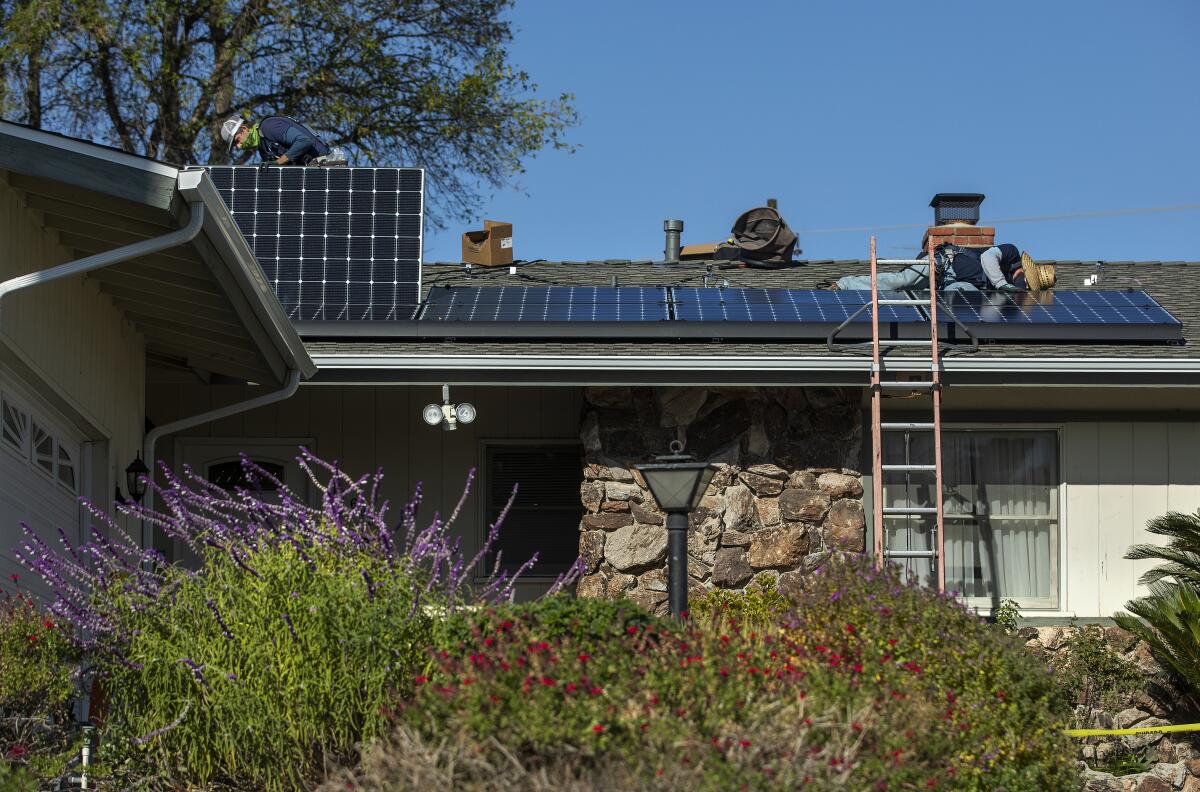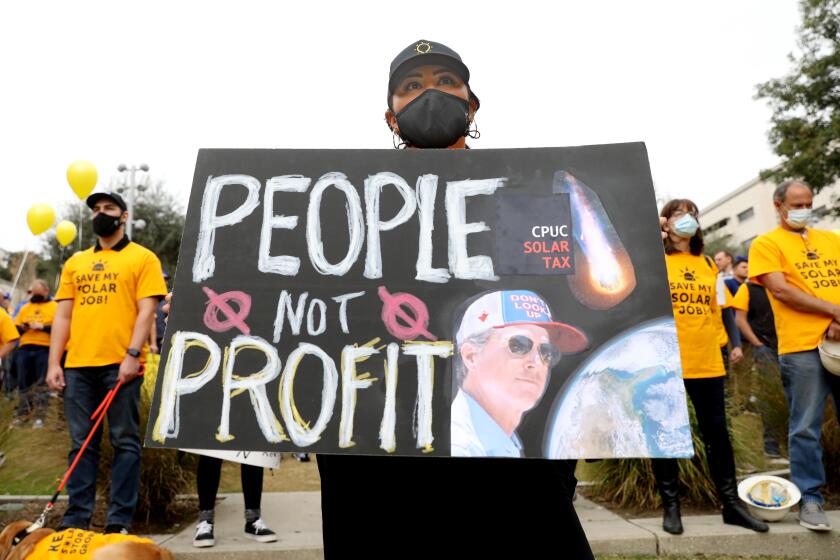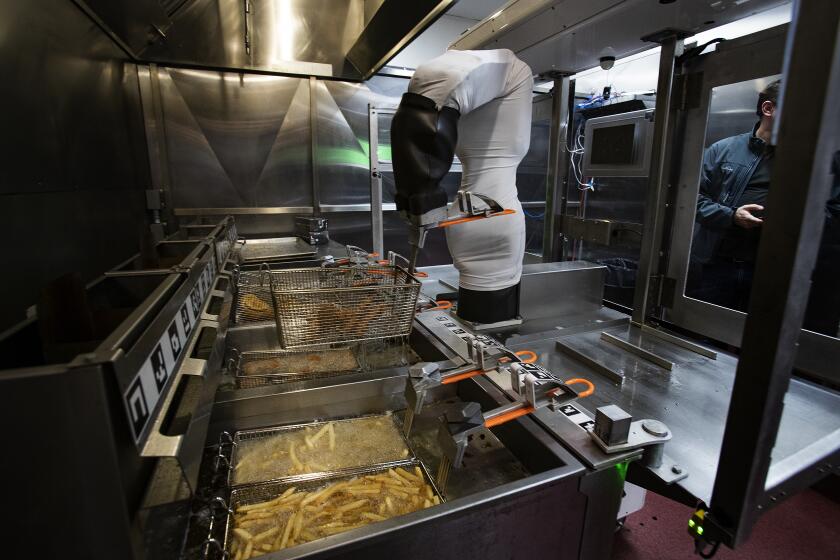Op-Ed: Sorry, rooftop solar supporters, California incentives really do punish the poor

When the California Public Utilities Commission proposed scaling back subsidies for rooftop solar in December, it cracked open a hornet’s nest of residential solar sellers, owners and advocates. Installation companies argued it would tank their profits and harm their workers. Solar homeowners and those who want to go solar said it would rob them of their only defense against soaring electric bills. Some clean energy partisans stewed about cutting back on any source of renewables.
The backlash sent the CPUC back to the drawing board. A revamped proposal will be out soon, but while we wait, it’s important to understand why changes were needed in the first place.
California’s solar rooftop incentives are based on what’s known as net energy metering. It works by crediting solar households with the full retail price of electricity when they pump power into the grid, even though other power providers are paid a far lower, wholesale price for what they generate.
The difference between the wholesale and retail prices is what pays for the system’s fixed costs, including most transmission and distribution costs, wildfire mitigation (think cutting trees and bushes around power lines), compensation for past victims of wildfires, subsidizing energy-efficiency programs and low-income customers, and making investments in new renewable technologies. As solar households consume less utility-provided power or export more power to the grid, those fixed costs don’t decline much if at all.
Based on data from the CPUC, the Energy Information Administration and other sources, my colleagues and I calculated the result: Utility customers who install solar save 20 to 30 cents for every kilowatt-hour their system produces, but the utility’s costs go down by only 7 to 9 cents. That leaves 10 to 20 cents in costs that still must be covered, so electricity rates go up, which hits people without solar panels.
In California, households installing solar are disproportionately wealthy (as well as disproportionately white), so the result is clear: Net energy metering shifts costs onto the poor.
California’s rooftop solar program leads the nation, but now has to evolve.
Rooftop solar advocates disagree, throwing out a litany of claims that attempt to explain why there is no cost shift, or that it isn’t big enough to matter, or that it doesn’t really hurt the poor.
Claim 1: Rooftop solar reduces pollution, and the monetary benefits of that must be added to the estimated utility savings. In fact, the savings estimate does take into account reduction in local pollution damage and climate change. In fact, the figures overstate the environmental benefits of rooftop solar because new installations in California aren’t crowding out polluting power generation. The alternative would be large-scale wind and solar power that is three to five times cheaper than rooftop solar.
Claim 2: Rooftop generation is local, so it saves on distribution costs. True, but studies based on detailed engineering or total-cost accounting show those savings are tiny — less than 1 cent per kilowatt-hour — compared with the size of the cost shift onto non-solar households.
Claim 3: Low-income customers are protected from the cost shift because California mandates reduced electricity rates for them. The California Alternative Rate for Energy program indeed lowers the price of electricity for poor customers, with a 30% to 35% discount. But that just means the cost shift onto the poor is 65% to 70% of the shift onto others — a smaller but still substantial burden for those who can least afford it.
Equally important: You have to be really struggling financially before you qualify for the discount, earning less than $53,000 a year for a family of four. That’s above the poverty level in California, but it doesn’t leave any spare funds for subsidizing solar for the wealthy.
Claim 4: Rooftop solar helps low-income customers because it allows the state to shut down conventional electricity generation that pollutes their neighborhoods. There is now so much solar energy produced in California that adding more is not helping to shut down power plants fired by conventional fuel. To shutter those polluting plants, we need generation that can produce when solar isn’t available — from batteries, “dispatchable” renewables (hydro or geothermal power) and imports from other areas — and we need to incentivize demand reductions at those times.
More than anything in state regulators’ proposal to slash rooftop solar incentives, the plan to slap a fixed monthly fee on solar customers must be scrapped.
Claim 5: Utilities want to end net metering because they are interested in increasing their profits, not in helping low-income families. Vilifying utilities is a clever strategy, but the loudest calls for ending the current net energy metering system are coming from the leading consumer advocate organizations: The Utility Reform Network and the CPUC’s Public Advocates Office, which estimates the cost shift from rooftop solar households to everyone else is more than $3 billion per year and quickly rising.
The Natural Resources Defense Council is also on board, in large part because of the equity issues. In fact, all the major environmental groups agree that the current net energy metering system creates a cost shift onto the poor, even if some of them objected to the CPUC’s December proposal.
Claim 6: As the cost of rooftop solar has dropped, more of the systems, and the subsidies, have gone to low- and middle-income households. Actually, the rooftop solar wealth gap has declined from enormous to merely huge.
A Lawrence Berkeley National Laboratory study found that in 2010, when the industry was tiny, the average income of solar adopters was 158% greater than the median California household income. By 2019, the gap was 54%. The gap is tough to close because not only are upfront costs a barrier, low- and middle-income families also have smaller roofs and are more likely to be renters.
And even if poor households increase their share of rooftop systems, the cost shift would remain inequitable, because other low-income households would still be paying for those systems. Like customers at a casino, some people would go home happy, but as a group they’d still lose.
Clean energy advocates want Gov. Gavin Newsom to protect the net metering program.
The bottom line is that California’s net metering policy is a regressive cost shift. It’s also undermining the state’s goal of replacing greenhouse gas emitting cars and home furnaces with clean electric alternatives because those options get less attractive each time rates go up.
If California wants to prioritize rooftop solar over large-scale renewables, the Legislature should subsidize it directly and transparently from the state budget, targeting the subsidies at lower-income families. That would increase fairness and reduce our sky-high electricity rates.
Climate solutions that aren’t equitable are not really solutions.
Severin Borenstein is a professor at UC Berkeley’s Haas School of Business and faculty director of the Energy Institute at Haas.
More to Read
A cure for the common opinion
Get thought-provoking perspectives with our weekly newsletter.
You may occasionally receive promotional content from the Los Angeles Times.









